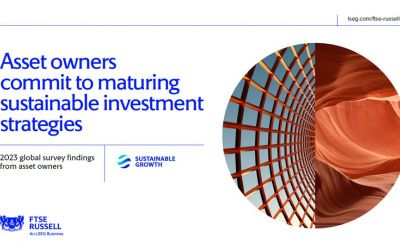The emerging trend poised to shape the future of sustainability strategy and reporting
Dynamic Materiality will become the new model for determining material sustainability topics to enhance future business resilience and ensure responsiveness to changing stakeholder expectations

Recent moments, movements, and events like #MeToo, Black Lives Matter, and COVID-19 underscore that shifts in stakeholder perspectives and priority issues can arise suddenly and present unexpected business risks – often in a manner that requires agile business responses and swift strategic pivots to mitigate risk exposure.
With more high-risk global events on the horizon, business leaders are finding it necessary to move beyond the “old ways of doing things” and re-think legacy business models, systems, structures, and processes.
AccountAbility, a global consulting and standards firm recognized for “Setting the Standard for Sustainability,” anticipates that this need to evolve business practices for adaptability and resiliency will drive corporate sustainability practices to become more dynamic in the year ahead – starting with advancements in Materiality Assessment tools, methodologies, and processes.
Materiality is Evolving – from Static to Dynamic
In the sustainability context, “Materiality” relates to identifying and prioritizing a business’s most relevant Environmental, Social, and Governance (ESG) topics, taking into account the impact each topic has on the organization and its stakeholders.
Materiality Assessment, therefore, is the process of capturing and distilling stakeholder priorities and the business impacts of sustainability issues through a combination of direct engagement with internal and external stakeholders, review of proxy data and industry research, and analyses of ESG risks and megatrends.
The outcomes of a Materiality Assessment may be leveraged to:
- Strengthen a company’s risk management processes
- Inform corporate strategy
- Prioritize sustainability commitments, targets, and programs
- Enhance reporting and disclosure
Historically, the outputs of these assessments are static in nature – capturing a moment in time and often resulting in a backward-looking view of business priorities. This static view quickly depreciates as organizations seek to develop strategies and disclosures that anticipate future conditions and business needs. However, the advent of Dynamic Materiality is poised to change this static perception and disrupt the future of sustainability and enterprise risk management.
Dynamic Materiality recognizes that what is considered material may change over time, and therefore takes a forward-looking, adaptive approach to reprioritizing ESG topics to allow for more regular action on newly identified risks.
This emerging methodology leverages big data and artificial intelligence (AI) to create real-time insights that assess the materiality of known and emerging issues – equipping companies to more effectively measure, monitor, manage, and disclose sustainability risks, actions, and performance in response to unanticipated events and rapid shifts in stakeholder expectations. This process is also designed to engage a broader range of stakeholders in the materiality determination process, capturing their perspectives throughout the year via “micro assessments.”
For example, TruValue Labs (TVL) has developed an ESG trends tracker that puts Dynamic Materiality into practice by using artificial intelligence (AI) to pinpoint the ESG issues that are becoming more important in our current world environment. In this case, the Dynamic Materiality model incorporates trend forecasting and scenario planning to take anticipated future risks – such as legislative changes, geopolitical trends, and macroeconomic shifts – into account.
Driving Forces for a Broader, More Dynamic ESG Mindset
As the Dynamic Materiality Assessment is future-focused and risk-conscious by nature, it can be an effective precursor to more dynamic corporate ESG actions – such as governance or risk management – that enhance resiliency and build stakeholder trust. As such, we have observed that dynamic systems are not isolated to the topic of the Materiality Assessment.
This shift to a more dynamic approach to business planning is already informing and improving company responses to COVID-19 disruptions, enabling the following outcomes.
- More agile risk management processes and teams, which Nestlé claims enabled its quick response to Covid-19.
- Development of business continuity plans, which allowed the real estate investment trust (REIT) Digital Realty to keep its data service centers fully operational during the shift to remote work.
- Informed investor decision-making, as is the case for Thomson Reuters and the UK’s Brunel Pension Partnership, with the support of TVL technology.
- Delivering a conscientious approach to stakeholder engagement for companies like Patagonia, Unilever, and Danone.
Further, we anticipate this trend will continue to become a greater component of the corporate ESG agenda, driven by market factors including:
- Intensifying Demands from the Investor Community: With mounting evidence to support its influence on positive financial returns, investors are demanding more accurate and transparent ESG data – a demand which is increasingly being met with emerging technologies like AI. Access to large volumes of ESG data in real-time allows investors to quickly determine which ESG issues are material to the performance of their investment portfolios. In turn, this places pressure on companies to more regularly monitor, manage, and report on ESG issues.
- Swift Shifts in Employee and Consumer Sentiment, which Impact Business Performance: Employees and consumers can drive a company to reconsider its stance on specific ESG issues – a power that is increasingly being exerted through strikes over working conditions, changes in purchasing behavior based on company ESG policies, or walk-outs to protest socioeconomic inequities. Ketchum’s Brand Reckoning 2020 study finds that 74% of American consumers think the Black Lives Matter movement has made it more important to support businesses that promote diversity and inclusion, while 88% are considering whether a company behaves ethically when shopping due to COVID-19. A more dynamic approach to sustainability can help a company be more prepared to anticipate and respond to swift changes in stakeholder demands.
Operationalizing the Path Forward
While a Dynamic Materiality Assessment – and the dynamic ESG mindset that accompanies it – cannot predict the future, it can strengthen a company’s understanding of stakeholder needs and improve its ability to forecast risk. As such, AccountAbility is actively incorporating more Dynamic Materiality models into our Materiality services to better equip our clients to navigate the rapidly evolving ESG landscape and enhance business resiliency.
Looking ahead, based on these trends and early outcomes showing the positive impacts of dynamic ESG practices on business performance, AccountAbility anticipates all elements of a company’s approach to sustainability – from reporting and disclosure to risk management to corporate governance – to become more dynamic in the future.
What is now an emerging trend toward dynamism, will soon become a leading practice across the industry.



_-_frame_at_0m5s_400_250_80_s_c1.jpg)


